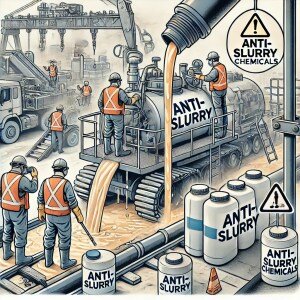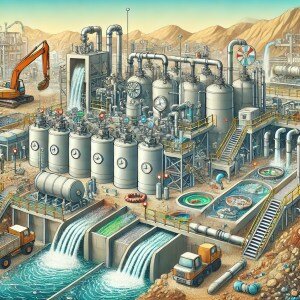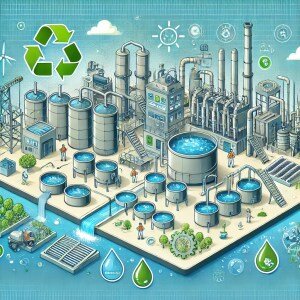Coal mining is one of the most important industries for the Indonesian economy.
Before we go further into the prevention of slurry buildup, it is important to understand what slurry is and why its buildup can be a serious problem. Slurry is a mixture of very fine solid particles (in this case, coal particles) with a liquid (usually water). In the coal mining process, slurry is formed when water is used to clean coal or when rainwater mixes with coal dust. Slurry buildup on mining equipment can cause a variety of problems, such as decreased operational efficiency, damage to machinery, and even safety risks to workers.
Preventing slurry buildup on mining equipment can be a challenge.
Preventing slurry buildup is not only important for maintaining operational efficiency, but also has a significant impact on the environment. Improper slurry management can lead to water and soil pollution around the mining area. Therefore, it is important for mining companies to have a comprehensive strategy in place to deal with this issue.
In this article, we will look at how to prevent slurry buildup.
In this article, we will discuss the various methods and technologies that can be used to prevent slurry buildup, ranging from water treatment techniques to the use of specialty chemicals. We will also look at how effective water management can help reduce slurry formation and improve overall operational efficiency.
Understanding the Causes of Slurry Buildup
Before we discuss ways of prevention, it is important to understand the factors that lead to slurry buildup on coal mining equipment. Some of the main causes include:
- Excessive water usage in the coal washing process
- High rainfall in the mining area
- Inadequate drainage system
- Coal characteristics that are easily crushed into fine particles
- Non-optimal equipment design for handling slurry
Understanding these causes will help us design effective prevention strategies. For example, if the main cause is excessive water usage, then the main focus of prevention can be directed towards optimizing water usage in the mining process.
Strategies to Prevent Slurry Buildup
Here are some strategies that can be implemented to prevent slurry buildup in coal mining equipment:
1. Optimization of Water Use
One of the most effective ways to reduce slurry formation is to optimize water usage in the mining process. This can be done in several ways:
- Using a more efficient water spraying system
- Implementing water recycling systems to reduce new water consumption
- Using sensors to control the amount of water used in the coal washing process
By reducing the amount of water used, we not only reduce slurry formation, but also save precious water resources. This is in line with the sustainability principles that are increasingly important in the modern mining industry.
2. Drainage System Improvement
 Betagard coagulants, for example, is one product that can be used to aid the coagulation process in mine water treatment.
Betagard coagulants, for example, is one product that can be used to aid the coagulation process in mine water treatment.
4. Optimal Equipment Design
Well-designed mining equipment can significantly reduce slurry buildup issues. Some design features that can help include:
- Smooth, corrosion-resistant surfaces to prevent slurry sticking
- Automatic cleaning system on the equipment
- Design that facilitates slurry flow in the desired direction
Investment in equipment specifically designed to handle slurries may require higher initial costs, but can save long-term costs by reducing downtime and maintenance costs.
5. Implementation of Monitoring and Control Systems
A sophisticated monitoring and control system can help detect and prevent slurry buildup before it becomes a serious problem. This can include:
- Sensors to monitor slurry levels at various points in the mining process
- Automated systems to regulate water and slurry flow
- Data analysis software to identify trends and potential problems
Systems such as the Betaqua Sentinel WS can be used to monitor various parameters of a water treatment system, including slurry levels.
Water and Waste Management in Coal Mining
Prevention of slurry buildup is closely related to effective water and waste management in coal mining operations. Here are some important aspects of water and waste management:
1. Mine Water Treatment
 Betaqua clarifier can be used to separate solids from liquids in the mine water treatment process.
Betaqua clarifier can be used to separate solids from liquids in the mine water treatment process.
2.
2. Water Recycling
 Betaqua's reverse osmosis system and Betaqua's ultrafiltration system are examples of technologies that can be used for the mine water recycling process.
Betaqua's reverse osmosis system and Betaqua's ultrafiltration system are examples of technologies that can be used for the mine water recycling process.
3. Solid Waste Management
Solid wastes, including compacted slurries, must be properly managed to prevent environmental impacts. Some solid waste management methods include:
- Drying: to reduce waste volume
- Stabilization: to prevent the release of contaminants into the environment
- Reutilization: using the waste for other purposes, such as land reclamation
Equipment such as the Betaqua screw press can be used to reduce the moisture content in solid waste, making it easier to manage.
The Importance of Routine Maintenance and Care
In addition to the prevention strategies already mentioned, regular maintenance and care of mining equipment is also very important in preventing slurry buildup. Some important aspects of maintenance include:
- Regular cleaning of equipment to prevent slurry buildup
- Regular inspection to detect damage or wear and tear on the equipment
- Timely replacement of worn or damaged parts
- Proper lubrication of moving parts
Good maintenance not only prevents slurry buildup, but also extends the life of the equipment and improves overall operational efficiency.
The Role of Technology in Slurry Buildup Prevention
Technological advancements have brought about various innovations that can help in the prevention of slurry buildup. Some of the promising technologies include:
- Automation systems to control water and slurry flow
- Advanced sensors to monitor equipment conditions in real-time
- Data analysis software to predict and prevent problems before they occur
- Ultrasonic-based cleaning technology to remove slurry from equipment surfaces
Investment in these technologies may require significant upfront costs, but can result in long-term savings through increased efficiency and reduced downtime.
Conclusion
Preventing slurry buildup on coal mining equipment is a complex yet important challenge to overcome. By implementing the right combination of strategies, ranging from optimization of water usage to utilization of advanced technologies, mining companies can significantly reduce this problem.
It is important to remember that there is no such thing as a silver bullet.
It is important to remember that there is no "one-size-fits-all" solution to preventing slurry buildup. Each mining operation has unique characteristics that require a customized approach. Therefore, it is important for mining companies to work closely with experts in the field of water and waste management to develop the most effective strategy for their operations.
Moreover, slurry prevention is not a one-size-fits-all solution.
In addition, slurry buildup prevention should be seen as part of a broader approach to environmental management and sustainability within the mining industry. By implementing best practices in water and waste management, mining companies can not only improve their operational efficiency, but also contribute to environmental preservation and sustainable development.
Finally, it is important to recognize the importance of slurry buildup prevention in the mining industry.
Finally, it is important to continue research and development in this area. New innovations in water treatment technologies, environmentally friendly chemicals, and equipment design can bring more effective and efficient solutions to prevent slurry buildup in the future.
With a commitment to continuously improve slurry and water management practices, the coal mining industry can move towards cleaner, more efficient, and more sustainable operations.
Questions and Answers
Q1: What are the environmental impacts of uncontrolled slurry buildup?
A1: Uncontrolled slurry buildup can lead to various negative environmental impacts. First, slurry containing coal particles and other contaminants can contaminate water sources around mining areas if not managed properly. This can damage aquatic ecosystems and affect water quality for human consumption and agriculture. Secondly, slurry buildup can cause soil erosion and changes in local topography. Thirdly, if slurry dries up, it can cause air pollution through flying coal dust. Lastly, poor slurry management can lead to the release of heavy metals and other harmful substances into the environment, which can have long-term effects on human and ecosystem health.
Q2: How to choose the right chemicals to prevent slurry buildup?
A2: The selection of the right chemical to prevent slurry buildup depends on several factors. First, the characteristics of the slurry itself, including mineral composition, particle size, and pH. Second, the intended use of the chemical, whether for flocculation, coagulation, or dewatering. Third, operational conditions such as temperature and pressure. Fourth, environmental considerations and applicable regulations. It is important to conduct laboratory tests and pilot-scale tests before selecting a particular chemical. Consultation with a chemist or chemical supplier such as PT Beta Pramesti is also highly recommended to ensure proper selection and safe and effective use.
Q3: Are there any promising new technologies for slurry management in the future?
A3: Yes, there are some promising new technologies for slurry management in the future. One is the use of nanotechnology for water treatment, which can help remove contaminants more effectively. Advanced membrane technologies such as forward osmosis are also being developed to improve the efficiency of water separation from slurries. In addition, the use of artificial intelligence and machine learning for the optimization of slurry management processes also shows great potential. These technologies are still in the early stages of development or testing, but they offer exciting prospects for more efficient and environmentally friendly slurry management in the future.
References
1. Pincus, L. I. (n.d.). Practical Boiler Water Treatment including Air-Conditioning Systems. "Higher total dissolved solids and more sludge increase the possibility of boiler priming, foaming, and carryover. Usually the concentration of solids can be held within safe limits by regulating the blowdown from the boiler." (p. 179)
2. Parsons, S., & Jefferson, B. (n.d.). Introduction to Potable Water Treatment Processes. "Pulsator, sludge removal, vacuum pump, raw water distribution system, sludge blanket upper level, sludge thickening cones" (p. 62)
3.
3. Hussain, A., & Bhattacharya, A. (n.d.). Advanced Design of Wastewater Treatment Plants Emerging Research and Opportunities. "Digestion and Disposal of Primary and Secondary Sludge, Methane, Carbon Dioxide, Fuel Value, Boiler Efficiency" (p. 297)
4.
4. Spellman, F. R. (n.d.). Handbook of water and wastewater treatment plant operations. "Chemicals are thoroughly mixed with the wastewater. The chemical reactions that occur form solids (coagulation). The solids are mixed to increase particle size (flocculation). Settling or filtration (separation) then removes the solids." (p. 759)
5. Binnie, C., & Kimber, M. (n.d.). Basic Water Treatment (5th Edition). "The earlier forms of hopper-bottomed basins had inherent weaknesses and were expensive to build and difficult to operate on silty rivers. However, they operated on a principle that was basically desirable, the upward passage of water through a zone of mature floc particles that captured and retained the fine particles in the incoming water." (p. 128)
